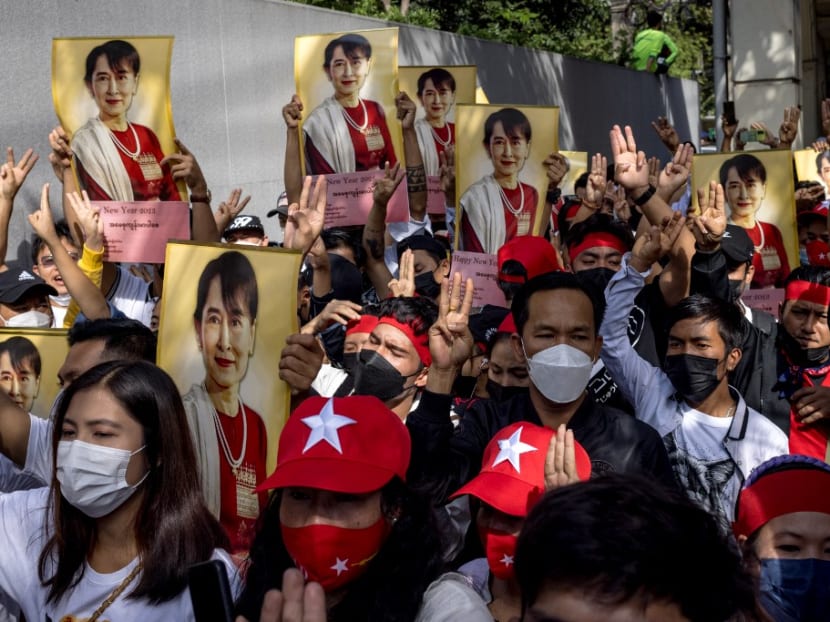Lack of progress in Myanmar crisis straining Asean unity, but 5-point peace plan still best option: Analysts
SINGAPORE — Even though the lack of progress in Myanmar has frustrated the Association of Southeast Asian Nations (Asean) and impacted its members' unity towards this thorny issue, the five-point consensus to restore peace in Myanmar is still the best option on the table, several analysts said.

Protesters holding up pictures of detained Myanmar civilian leader Aung San Suu Kyi during a demonstration outside the Embassy of Myanmar in Bangkok, Thailand on Dec 19, 2022.
- Over two years after it was agreed upon by the Association of Southeast Asian Nations (Asean) members, the five-point consensus on the Myanmar crisis has seen little progress in its implementation
- Despite this, Asean is likely to stick to it, given the lack of other viable peace plans, analysts told TODAY
- Harsher actions would risk going against the principle of non-interference in members’ domestic affairs, a cornerstone principle of regional grouping
- Meanwhile, the protracted crisis has cast a spotlight on different approaches taken by Asean members, said some observers
SINGAPORE — Even though the lack of progress in Myanmar has frustrated the Association of Southeast Asian Nations (Asean) and impacted its members' unity towards this thorny issue, the five-point consensus to restore peace in Myanmar is still the best option on the table, several analysts said.
Any newer and harsher action plan would risk crossing the bold red line of non-interference that forms the bedrock of regional grouping, political observers said, adding that achieving a fresh consensus on such a politically complex issue would be challenging.
Speaking to TODAY after the 42nd Asean Summit in Indonesia that concluded last week, experts noted various ways in which the Myanmar conflict that began after a military coup broke out in Feb 2021 exposed internal disagreements and positions taken by Asean member states since then.
These included differing statements made by individual Asean leaders, and the willingness by some members to engage Myanmar’s military junta on the side, even though Asean has largely excluded its political leaders from the grouping's meetings.
Thousands have died since the coup, with latest figures from human rights group Assistance Association for Political Prisoners putting the number of people killed by the junta as over 3,500. At least 170 civilians were reportedly killed in the latest military air strike on a central Myanmar village in April.
The Myanmar crisis was among the key issues discussed at the summit, in which Indonesia’s President Joko "Jokowi" Widodo acknowledged a lack of real progress on the five-point consensus and called upon unity among Asean members in order to chart progress on the crisis. Indonesia is the 2023 chair of Asean.
His comments come in the wake of an attack of an Asean convoy in Myanmar en route to delivering humanitarian aid, which included Singapore diplomats.
The five-point consensus refers to the peace plan that was agreed upon by all Asean members in April 2021 including the Myanmar military, two months after the latter overthrew the country’s civilian government in a coup that plunged the country into turmoil.
On May 11, Prime Minister Lee Hsien Loong stressed the need to “maintain a consistent rational policy” to arrive at the best outcome for Myanmar and for Asean.
Mr Lee told Singapore media that while some other Asean members share the same view as Singapore, there are also "other views" within Asean as well and these views are what the grouping will discuss moving forward.
LACK OF MEANINGFUL PROGRESS
The five-point consensus calls for an immediate end to violence, holding dialogue among all parties, the appointment of a special envoy, allowing humanitarian assistance by Asean and allowing an Asean special envoy to visit Myanmar to meet with all parties.
The chairman’s statement issued at the end of the 42nd summit “observed some movements on the humanitarian front” with regard to the peace plan.
Mr Jokowi also acknowledged on the last day of the summit on Thursday that there was "no significant progress" on implementing the peace plan.
Mr Dedi Dinarto, lead Indonesia analyst at strategic advisory firm Global Counsel, said that he was “not surprised by the lack of meaningful progress”, given the “ongoing intense conflict” that makes constructive dialogue between the military government and the pro-democracy camp unlikely.
He added that the junta has “gained legitimacy” and support from various external parties, including in the form of military equipment and foreign direct investment, thus giving it less incentive to cooperate with Asean and implement the peace plan.
Asked about the status quo between Asean and Myanmar following the attack, Ms Joanne Lin from the Iseas-Yusof Ishak Institute said: "It is not surprising because the (junta) seems to be on its own path to decide its own future regardless of the actions of Asean or the international community.
"At this point, Asean has little influence on the military government, which is still able to extract a fair amount of concessions from other countries such as Russia and China."
Ms Lin is the lead researcher and co-coordinator for the Asean Studies Centre at the Iseas-Yusof Ishak Institute, a research centre dedicated to the study of socio-political and economic developments in Southeast Asia.
Experts said, though, that Asean's peace plan is still the best option in the absence of others.
Noting that the Asean chairman's statement touched on how members also reiterated during the latest summit that the five-point consensus “remains our main reference”, Ms Lin said that there were no objections from the grouping's members over the plan's relevance.
“Asean leaders will therefore not abandon the five-point consensus despite the lack of progress made. This is a document that has been agreed upon by all 10 members of Asean (including Myanmar’s military leader).”
Dr Mustafa Izzuddin, senior international affairs analyst at Solaris Strategies Singapore, said that should the grouping decide to discard the current consensus, arriving at a new one would be challenging.
“A new framework will need to be devised that would require the military in Myanmar to also agree to it, but which may prove to be more difficult with Myanmar being disinvited from Asean meetings.”
Dr Mustafa is also a visiting professor of international relations at the Islamic University of Indonesia.
Since October 2021, Asean has agreed to only invite non-political representatives from Myanmar to its meetings, owing to the lack of progress in the implementation of the peace plan.
DISUNITY AMONG NEIGHBOURS?
In the meantime, some analysts said that the frustration brought about by the protracted issue has cast a light on disunity in Asean, as can be seen in the most recent developments in the lead-up to the Asean Summit in Indonesia.
“(This is) reflected in the proposal of several member states during the Asean Summit to invite junta officials back to high-level meetings,” Mr Dedi from Global Counsel said.
An internal report on the foreign ministers' discussions at the summit said that some countries wanted to invite the junta back to Asean meetings because "the time for isolation has served its purpose", news agencies AFP and the Associated Press reported.
The suggestion for Asean to bring Myanmar back into its fold was “noted”, the internal report said, hinting that it did not receive full approval from all the ministers.
Still, some analysts pointed to efforts by Asean members to engage Myanmar outside the grouping as yet another sign of disunity.
Dr Felix Tan, a political analyst from the Nanyang Technological University, referring to a Track 1.5 dialogue on the issue initiated by Thailand, said: “Let's not forget how Thailand had organised an informal Asean meeting, together with Cambodia, Laos and Vietnam to meet with the Myanmar military junta leader Min Aung Hlaing.”
Track 1.5 diplomacy commonly refers to conversations held between non-governmental parties and government officials attending in an unofficial capacity.
The dialogue was initiated by Thailand as a way of opening more channels for dialogue among stakeholders affected by the Myanmar crisis and is aimed at promoting mutual trust and confidence, Thai PBS media outlet reported.
Reuters, Nikkei and Thai PBS reported that a second round of such dialogues was hosted by India last month in New Delhi.
Mr Dedi took a different view on the Track 1.5 approach, suggesting that it “should be interpreted as a series of parallel initiatives to engage with the military government in Myanmar, rather than a sign of disunity,” adding that Indonesia, too, held back door diplomacy engagements with Myanmar.
The analysts added that due to the protracted conflict, Myanmar’s immediate geographical neighbours may face specific sets of issues — such as concerns over movements of refugees or drug trafficking — with which other members do not have to grapple.
Ms Nydia Ngiow, managing director of advisory firm Bower Group Asia Singapore, said: “The longer the status quo remains, the greater the impact felt by Myanmar’s neighbouring economies and the more apparent disunity among Asean leaders will be.”
Ms Lin of Iseas-Yusof Ishak Institute said that the diversity of views in Asean needs to be seen in the right context.
“Fundamentally, it is important to understand that Asean is only an inter-government organisation to promote cooperation (unlike the European Union).
"Asean member states certainly do not need to align themselves with foreign or security policies,” she said, adding that Asean members “may not see eye-to-eye” over other issues as well.
WOULD ASEAN TAKE HARSHER ACTIONS?
Prime Minister Lee told the media on Thursday that fundamentally, the crisis in Myanmar is “a domestic situation” and a power struggle between different groups.
The analysts highlighted that non-interference in the internal affairs of its members is one of the key principles in the Asean Charter.
Mr Dedi from Global Counsel described this as a “clear red line” that leaves the grouping no other choice but to stick to the agreed-upon five-point consensus.
Agreeing, Dr Tan of NTU said: “Any other tougher measures on Myanmar's internal crisis would mean that Asean is breaking with its own constitutional protocols and that would certainly be a big 'no-no'.”
Ms Ngiow of Bower Group Asia said that further moves might “risk jeopardising the fragile balance” and “pose a significant risk to Asean’s social fabric and economic activities”.
“(This) should be avoided especially against the backdrop of global economic uncertainty and the United States-China tensions.”
Ms Lin of Iseas-Yusof Ishak Institute said that there are some Asean member states “that could identify with the military regime more than others”. She did not state which nation she is referring to in this instance.
“(They) therefore would be unwilling to participate in actions that might interfere with the decisions of the regime, for fear that such interference might also happen to their countries in the future,” she added.
Dr Mustafa said that the only other action “that could send shockwaves” is to suspend Myanmar’s Asean membership, though he dubbed such a move “implausible”.
“Sticking with the five-point consensus but equipping it with more ‘teeth’, especially in embarking on tough diplomacy, strengthening enforcement mechanisms and taking hard-nosed decisions is a more plausible option.”








